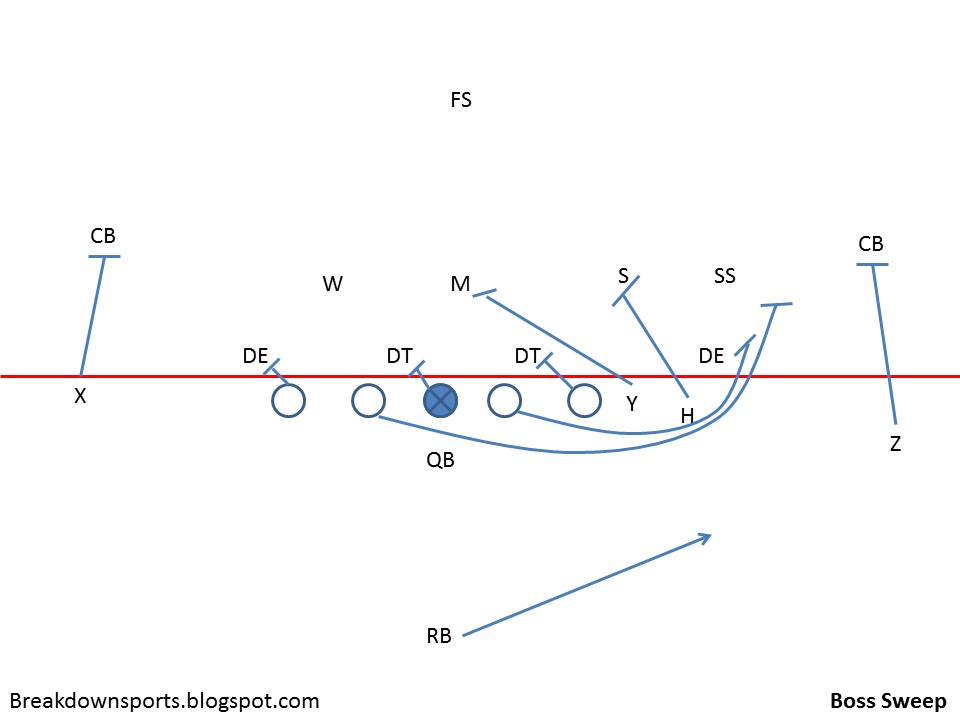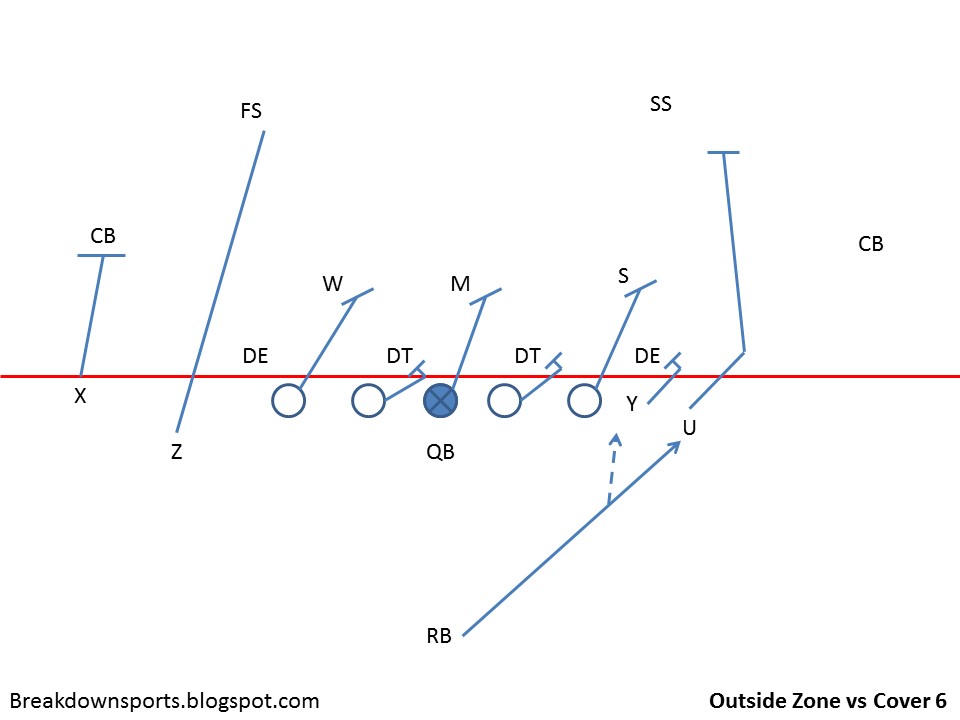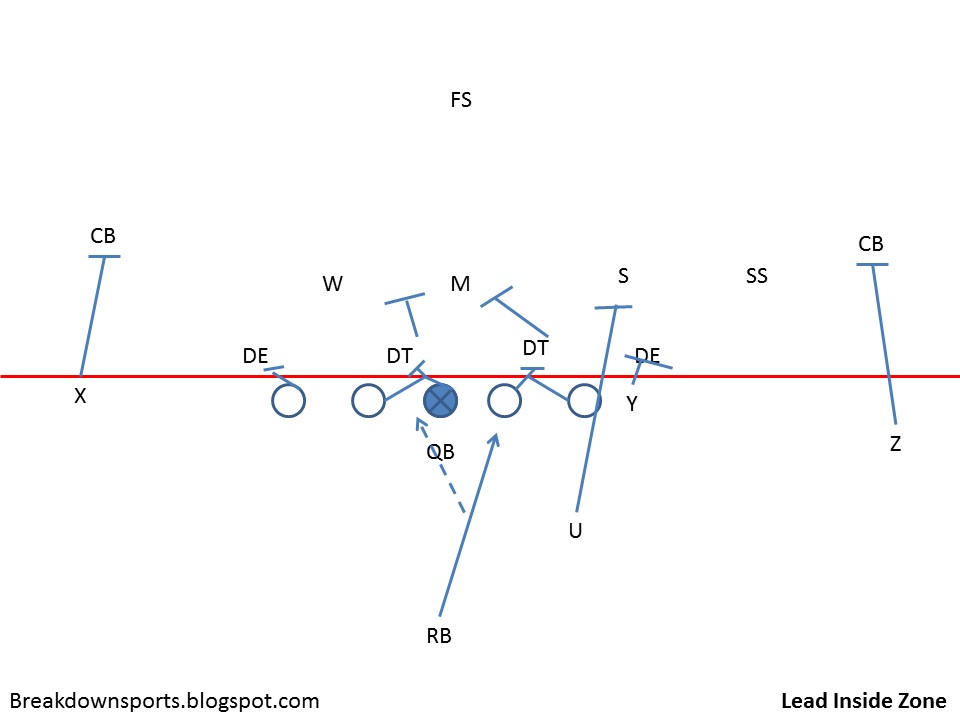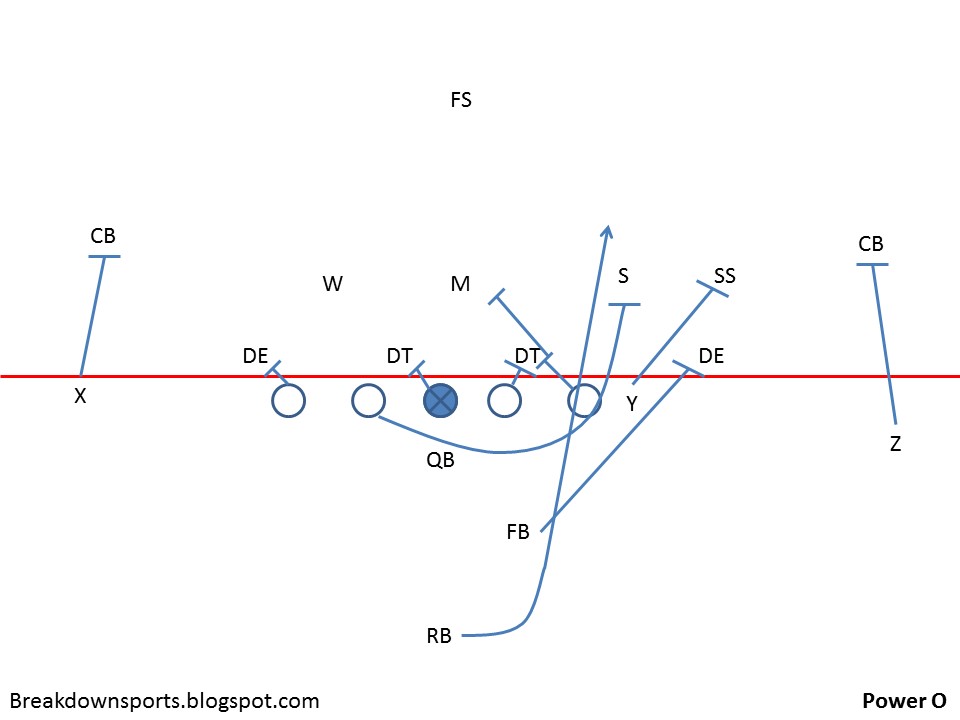Film Review: Attacking Ohio State's Defense, 2014
ORIGINALLY POSTED AT BUCKY'S 5 QUARTER ON 12/5/14
The Ohio State offense is very good, as is the Wisconsin defense. In many ways, this could be the talk of Saturday's Big Ten Championship Game, similar to how the OSU offense against the Michigan State defense was the talk heading into last year's title game.
In my opinion, though, when two teams have very good opposing sides of the ball, they tend to cancel out in many ways, and where the game swings is on the other end. In this way, it is up to the Badger offense to step up and make the difference. In this post, we'll look at what the Ohio State defense brings to the table, areas in which it's struggled this year and how you can expect Wisconsin to attack.
Let's look at a few examples.
The defensive line gets sucked upfield and the running back gets to the edge. The linebackers are late to react downhill and get caught at the second level.
Jet Sweep (something that Wisconsin has been successful with from its two-running back sets): Catch OSU in Double A gap blitz, edge sealed with crack block (was a theme against Michigan as well, Ohio State not great at crack exchange).
Outside Zone: Look how much stagger and space there is between each player on the play side. Not a wall. Lots of choices for the running back. Linebackers attacked to blockers, not getting off. Backside pursuit is late. Defensive backs not holding point of attack and lets play get outside.
Here, Indiana combines two of the methods with which I think Wisconsin can hurt Ohio State. They both attack the edge and the knob. Likewise, they break tendency by running zone-stretch toward the running back alignment and run a pin-and-pull scheme. This pin-and-pull scheme takes out the defensive line and forces the linebackers to make plays, in which they fail (which is why I put this in this section). They don't take proper run fits or angles, and this allows Tevin Coleman to break into the third level rather easily.

Now, unfortunately for OSU, the cornerbacks are pretty poor in run support, just as they were last year and as Wisconsin exploited.
Let's look at some examples from this year.
Attack DBs with Knob formations: Cover 4 checks to Cover 6 when no split out, OSU defensive backs really struggle on the edge. Wisconsin utilized this against Nebraska quite a bit with success; Ohio State really struggled against these looks. Also watch though how the linebackers hesitate into the hole rather than burst through. This is a play that should be a tackle for loss, but they are slow and hesitate in their attack.
Again, attack Knob formation. Look at the stagger between levels again. Linebackers sucked out of position. Huge hole with no one filling as that linebacker is very late to read and gets an offensive tackle in his face. Linebackers blitzing get caught in wash rather than working over to hole; not tight enough to butt of the offensive line.

Once you threaten the edge, you can work back inside. This is Power O Lead (something Wisconsin also runs), where the jet motion acts as the kick block. But notice the blocking combining with zone blocking. Now the defensive line is pinned, and the linebackers get sucked right up and don't play assignments or reads. This is not a big gain because someone on the line can disrupt the running back a bit and he isn't quick enough to the hole. If this is Gordon, he's going against safeties to prevent a touchdown, though.
This is a counter play where Michigan State gets called for a hold (and the turning point of the OSU-MSU game). But the Counter H is very successful, again, with a knob formation where the cornerback is weak in run support. The back-side linebacker is very poor in his keys, and never makes a play on the ball while getting sealed on the backside. The front-side linebacker is caught 2 yards off the LOS by a pulling offensive lineman.
This forces the defense to start hesitating. Once OSU starts hesitating, a decent back picks up good yardage; a great back gets into the third level. Guess what Gordon is.
This is a short gain on Inside Zone, but it demonstrates the point of OSU linebackers being slow to crash down or being poor in run fits. Here, they wait and wait, and that allows offensive linemen into the second level and produces a nice 4-yard gain.

Let the defensive line take itself out of the play by over-penetrating. Michigan State utilized quite a few traps, which Wisconsin doesn't do. Wisconsin could implement some Wham blocks into its inside-zone blocking scheme in much the same way. The Badgers also utilize some gap running plays, such as the true inverted veer they ran earlier this year with success (it wasn't the power read, but an actual gap-oriented, front-side read play, which would force OSU's defensive linemen to penetrate and take themselves out of the play). And again, the linebacker here should see the hole very clearly and shoot it. Instead, he waits and gets caught off the LOS by the offensive lineman and that allows a marginal gain. The difference between 4 yards and zero yards.
This gets the linebackers to hesitate something serious. Michigan worked a lot of the quick-passing game early (which we'll get to in the next section); countering that with the lead draw froze the OSU linebackers and allowed the offensive linemen and fullback to get into the second level and keep them there.
This works to counter both inside zone and Power O. The initial blocks by the offensive line look like Inside Zone. The pulling guard makes it makes the setup look a lot like a typical counter to inside zone: Power O. However, the guard isn't really pulling; instead, he's folding. This means the running back is attacking the A-gap. In the play, you see the OSU linebackers overrun the play something terrible as Indiana breaks tendency.
Wisconsin can do a few things here: run zone as a base, but then also run Power O, Counter H, Boss Sweep, etc., and mix up a lot of the keys that way. But the Badgers also will run split zone and lead zone, and in this way, they can alter the motion in the backfield to also force the OSU linebackers to hesitate.


Cover 4 MOD: can pin linebackers inside and hit the quick hitch outside.
Lots of early-down blitzes from the Buckeyes; they like to bring six men on pressure, which means a 5 (3 deep, 2 under) zone behind. Can exploit underneath. Must get rid of ball quickly; cornerbacks play tight and underneath defense follows eyes.
Then it's play-action to pull out the linebackers, and it's easy pickings in the flat.
Zone Stretch fake and keep the back-side H-back in to block the back-side defensive end. Then run play-action off of it, settle the outside receiver in the short/intermediate and take advantage of OSU's MOD coverage, which forces the linebacker to cover the flat.
Double Move to tight end for a MSU touchdown vs OSU. Here, the Buckeye safety and cornerback are not on the same page. The cornerback has over-the-top inside help and can't work inside. The cornerback can't bite down when there is a bracket coverage on a guy.
Wisconsin will almost certainly get big chunks at times against Ohio State. The key for the Badgers will be to not allow big plays the other way. The Buckeyes want to get the Badgers behind the chains, they want to force them into obvious passing situations. If they can get Wisconsin into those situations, they are athletically gifted enough to make a bad situation worse and drastically flip field position, an area in which the Buckeyes are one of the best in the nation. That sets up the offense and gives it an advantage against the Badgers' stout defense.
So the key needs to be to stay out of those situations. Don't get stacked up at the line of scrimmage (which Wisconsin does at times) and remain multifaceted so that Ohio State can't guess its way into big plays with well-timed blitzes and stunts. If the Badgers can do that, they can have another big game offensively. If they can't, they'll still get chunk plays, still put up yards, still score points, but they'll also put Ohio State in a position to counter those chunk plays, or worse yet for Wisconsin, do better.
The Ohio State offense is very good, as is the Wisconsin defense. In many ways, this could be the talk of Saturday's Big Ten Championship Game, similar to how the OSU offense against the Michigan State defense was the talk heading into last year's title game.
In my opinion, though, when two teams have very good opposing sides of the ball, they tend to cancel out in many ways, and where the game swings is on the other end. In this way, it is up to the Badger offense to step up and make the difference. In this post, we'll look at what the Ohio State defense brings to the table, areas in which it's struggled this year and how you can expect Wisconsin to attack.
Ohio State's Defense
Let's first take a look position group by position group at the strengths and weaknesses of each.Defensive Tackle
Between Michael Bennett and Adolphus Washington, these two defensive tackles are likely the most dangerous pass rushing pair in the Big Ten. They are extremely quick and do a great job setting up offensive linemen to get inside pressures. Against the run, they are always a danger to blow up a play, but also always a danger to take themselves out of a play. They shoot gaps fast and hard, but often times don't sufficiently maintain blockers or get too far up field.Defensive Ends
Joey Bosa is a pretty good player ¯\_(ツ)_/¯. Yeah, he's a pretty good player. Against the run, he does a great job of controlling his blocker and shedding at the point of attack. He's strong for a defensive end and can make it difficult to really get outside of him on stretch plays, as he tends to be able to gain width and depth to force cutbacks from the running back. He's violent with his hands and has a great inside move as his primary pass rush. I wouldn't attack him on read option plays, but instead attack him where he is forced to choose incorrectly (power read, inverted veer, speed option, play action). Across from him, you more often than not have Michael Bennett and Steve Miller. Miller is a good enough athlete to make some plays, and is a good player on twists and stunts. He can be attacked a bit in the run game though.Linebackers
Between Joshua Perry, Curtis Grant, Darron Lee and Raekwon McMillan, they have great athletes. Lee is great on the blitz, and current Ohio State defensive coordinator (and former Wisconsin DC) Chris Ash will send him on early-down and late-down blitzes often. Grant is more of a classic run stuffer, and Perry is a good athlete as well. McMillan is a phenomenal athlete, but also a true freshman. Where this unit really struggles is in technique and the speed at which they identify their keys. Often times, you'll see these linebackers take themselves out of plays, either by over-running plays, shooting upfield and not maintaining gap integrity, utilizing poor run fits or being late to get downhill. In other words, they flash. They flash great and they flash bad. They'll make a play in the backfield and make you remember why these were highly sought-after recruits, and then they'll catch a blocker 3-4 yards downfield and get stuck on the block.Cornerbacks
Doran Grant is clearly the better cornerback right now, and I much prefer Eli Apple over Gareon Conley or Armani Reeves at this point. Grant is more consistent (thus earning him All-Big Ten honors), but isn't a standout in my opinion. Apple is a good athlete that can make some plays, but still isn't really there from a technique standpoint. The Buckeyes run a lot of Cover 4 MOD, with the cornerbacks dropping off fairly quickly rather than locking onto their receivers. This makes their pass game a bit safer, but often times sees the defense attacked underneath and allows offenses to get into their route concepts and set up the defensive backs to lose leverage a bit. This unit can really be attacked in the run game.Safeties
Again, good athletes, but a real struggle with appropriate angles and run fits. A couple very good athletes and potential big hitters as well, they just seem to lack an understanding currently of angles and reads from the back end. They too often get caught trying to make the big play instead of the right play. They can be set up with double moves and play-action, and they aren't as aggressive as some other Cover 4 teams around the league coming down in run support. This leads to allow chunk plays for opponents.Get To the Choppa -- er, Edge!
You want to stay away from Bosa (most often lined up on the offense's right side) as much as possible. Running to the opposite edge is one way of doing that. Perhaps more important than that, it puts the emphasis of stopping the run on the linebackers and defensive backs. For a linebacker unit that struggles with appropriate reads and angles, combined with a penetrating defensive line, attacking the edge causes a lot of issues for this defense. As the linemen can potentially take themselves out of the play, attacking the edge tends to widen the line, which allows for gaps for backs like Melvin Gordon to cut vertically through. On top of that, with linebackers that shoot vertical (often on called blitzes) and other times are slow to diagnose their keys, this a staggered defensive front that is filled with gaps.Let's look at a few examples.

Attack the Knob
One of the ways in which Wisconsin was successful last year was utilizing formations that forced the cornerback to maintain the edge. Ohio State's base defense last year was Cover 6. Wisconsin is a team that loves to utilize tight ends, and as such, naturally comes out in a lot of knob formations (no receiver split from the formation to one side of the ball, typically to the boundary). The Buckeye's current base Cover 4 adjusts to Cover 6 against this look, and in this way, Gary Andersen, Dave Aranda and co., can dictate some of the ways OSU will attempt to leverage the ball carrier.Now, unfortunately for OSU, the cornerbacks are pretty poor in run support, just as they were last year and as Wisconsin exploited.

Counter with Man/Gap Schemes
Early in the Nebraska-Wisconsin game, Wisconsin was running mostly zone schemes and Nebraska's defensive line (its strength, especially relative to its linebackers) was able to win play-side and bottle up the run game. After the first couple of drives, Wisconsin started running a variety of man/gap blocking schemes such as Power O, Counter H and Boss Sweeps, and this allowed them to pin the defensive line a bit and put an emphasis on the linebackers and secondary of Nebraska, and that's when Gordon began his record-setting pace. Wisconsin can try to do a bit of the same against Ohio State.This forces the defense to start hesitating. Once OSU starts hesitating, a decent back picks up good yardage; a great back gets into the third level. Guess what Gordon is.

Give Them A Lot to See
Wisconsin won't necessarily use these same methods, and I can get into some of the methods the Badgers try in a second, but this is a way to attack the Buckeye linebackers that are often slow to diagnose plays as the develop. In the Cover 4 scheme, the Ohio State linebackers also have quite a bit of underneath coverage responsibility, and this can be exploited a bit, as can breaking keys.This gets the linebackers to hesitate something serious. Michigan worked a lot of the quick-passing game early (which we'll get to in the next section); countering that with the lead draw froze the OSU linebackers and allowed the offensive linemen and fullback to get into the second level and keep them there.
Wisconsin can do a few things here: run zone as a base, but then also run Power O, Counter H, Boss Sweep, etc., and mix up a lot of the keys that way. But the Badgers also will run split zone and lead zone, and in this way, they can alter the motion in the backfield to also force the OSU linebackers to hesitate.


Attack Underneath with the Pass
At points, Wisconsin will have to take some shots just to keep the safeties back (who will likely adjust a bit to Wisconsin's run-heavy offense). Rather than taking straight shots, though, the Badgers should set up the deep threat by first attacking shallow. These shallow concepts will lead to double moves, where the Wisconsin quarterbacks will have simpler reads and not be forced to make quite as accurate throws.Zone Stretch fake and keep the back-side H-back in to block the back-side defensive end. Then run play-action off of it, settle the outside receiver in the short/intermediate and take advantage of OSU's MOD coverage, which forces the linebacker to cover the flat.
Conclusions
All this makes it sound easy, but it isn't necessarily. I still think Ohio State has some very clear weaknesses on defense, and I don't think even the most homer Buckeye fan would admit otherwise. But the Buckeyes do have some great athletes and they do have a defensive line that can absolutely take over games. In the clips above, you don't see a lot of the sacks that happen because the defensive linemen are super athletic and use their hands really well. You don't see the big tackles for loss because they athletically shot a gap, which in turn set up those sacks.Wisconsin will almost certainly get big chunks at times against Ohio State. The key for the Badgers will be to not allow big plays the other way. The Buckeyes want to get the Badgers behind the chains, they want to force them into obvious passing situations. If they can get Wisconsin into those situations, they are athletically gifted enough to make a bad situation worse and drastically flip field position, an area in which the Buckeyes are one of the best in the nation. That sets up the offense and gives it an advantage against the Badgers' stout defense.
So the key needs to be to stay out of those situations. Don't get stacked up at the line of scrimmage (which Wisconsin does at times) and remain multifaceted so that Ohio State can't guess its way into big plays with well-timed blitzes and stunts. If the Badgers can do that, they can have another big game offensively. If they can't, they'll still get chunk plays, still put up yards, still score points, but they'll also put Ohio State in a position to counter those chunk plays, or worse yet for Wisconsin, do better.



Comments
Post a Comment